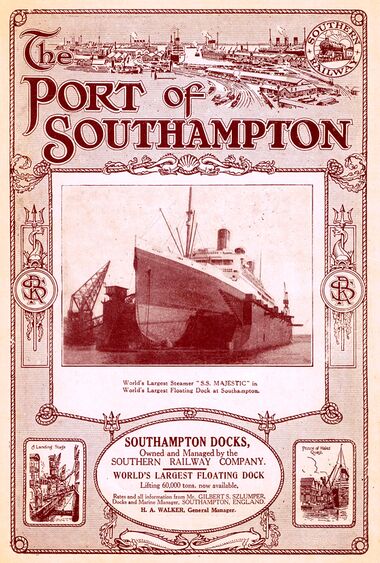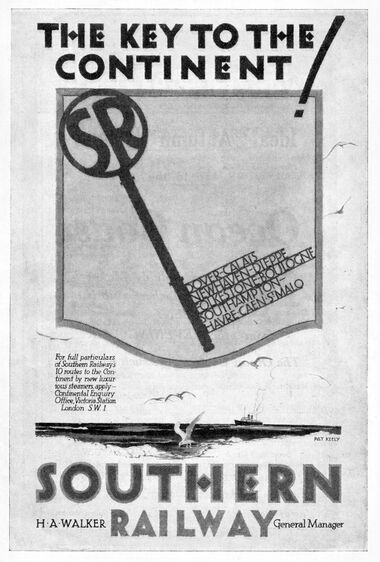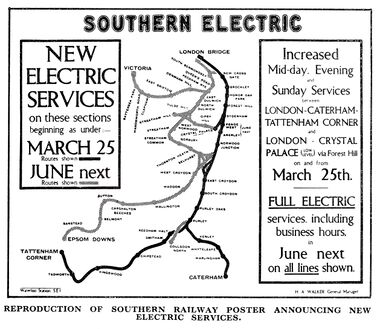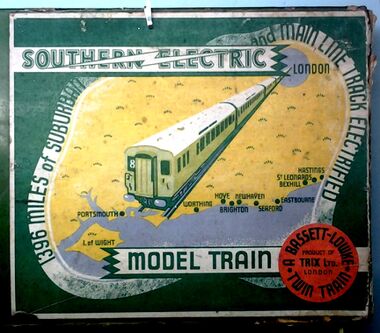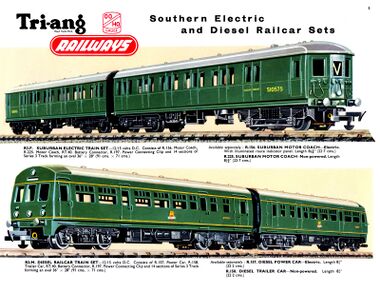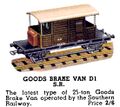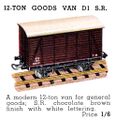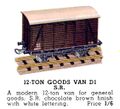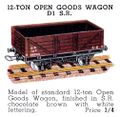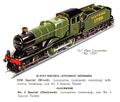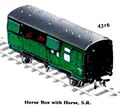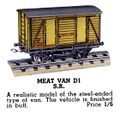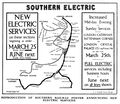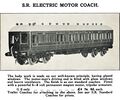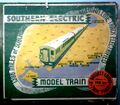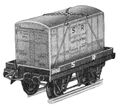Category:Southern Railway
| The "Big Four" railway companies |
|---|
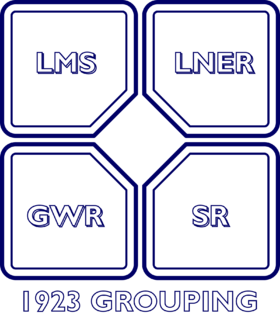 |
| Great Western Railway (GWR) |
| London, Midland and Scottish Railway (LMS) |
| London and North Eastern Railway (LNER) |
| Southern Railway (SR) |
1925 advert for Southampton Docks, featuring the S.S. Majestic [image info]
1925, "Southern Railway: The Key to the Continent!" [image info]
1928 or earlier, Southern electrification, map [image info]
1939: Southern Railway map, TTR "Southern" electric train set box artwork. This was a classic example of the SR publicity department hooking up with an outside company for mutual promotion. The train set box featured a map of popular Southern destinations, and was also specially produced in green to reference the Southern livery. [image info]
1958 Tri-ang Railways "Southern" sets [image info]
The Southern Railway, "SR", (1923-1948) was one of Britain's "Big Four" railway companies until the four were merged after World War Two to create British Railways (BR). After the merger, the operating subnetwork was known as "Southern Region".
Southern operated in the area between between London and the South Coast, and although the railway had less track-mileage than its competitors, its ownership of the routes between London's large population and the nearest section of coastline made Southern very profitable, with most of its profits coming from passenger services.
Southern built on its ability to shuttle passengers quickly to the southern seaside resorts by creating and promoting a fleet of named Pullman train services, the "Belles" and by mounting high-profile advertising campaigns. The company also benefited from their southern location by being able to run connecting services such as the Golden Arrow, which took holidaymakers to the coast, and then to a ferry service that connected to a European train service that could then take them to even sunnier places like the South of France.
Formation
Southern was created in 1923 merging of a number of smaller southern railway companies, primarily the London, Brighton and South Coast Railway (LBSCR) which had the London-to-Brighton route, the London and South Western Railway (LSWR), and the South Eastern and Chatham Railway (SECR).
- London and South Western Railway (LSWR)
- London, Brighton and South Coast Railway (LBSCR)
- South East and Chatham Railway (SECR)
- Lynton and Barnstaple Railway
- Freshwater, Yarmouth and Newport Railway
- Isle of Wight Railway
- Isle of Wight Central Railway
1923 overview
The Southern Railway (see map), smallest of the "Big Four", occupies, as will be seen, a compact territory in the South of England, only penetrated in the Western half by the Great Western Railway, and not itself encroaching upon the spheres of its neighbours. It is composed of three partners, of which the biggest, the London and South Western, was approximately equal in extent to both the others, the South Eastern and Chatham and Brighton railways. The total route mileage of the Southern system is 2,200 miles. Primarily, the Southern railway is a passenger-carrying system, serving all the holiday resorts of the Kent and South coasts and the Isle of Wight, as well as, in conjunction with the Great Western, Devon and Cornwall ; but it owns an important dock system, especially in Southampton docks, and has close connexions with the continent and with the Channel Islands. Doubtless the South Eastern portion will grow in importance with industrial developments in Kent, apart from the question of the construction of the Channel Tunnel. A great portion of this system lends itself to electrical working, and schemes are already in hand for the electrification of the whole of the Brighton line and of considerable portions of the South Eastern and South Western sections.
In addition to Southampton, there are docking and wharfing facilities at Bideford, Plymouth, Littlehampton, Newhaven, Folkestone, Dover, on the Thames and at Gravesend, Port Victoria and Queenborough. The Company owns wholly and jointly 17 turbine vessels; 21 other steamers and a number of smaller boats. The locomotive, carriage and wagon works are at Eastleigh (near Southampton), Brighton, Lancing, and Ashford (Kent).
Leading statistics are as follows : —
The total capital of the Company is about £145,000.000. For 1921, the gross receipts from railway operation only were £33,000,000, the total expenditure on railway working £28,500,000, and the net receipts, including all items, £5,500,000. The total passenger traffic for the year, excluding that represented by season tickets, was 171,470,000. The equivalent annual season tickets issued numbered 167,000, naturally heavy in proportion to the mileage in view of the residential character of a large part of the system. The freight traffic included general merchandise, 4,000,000 tons ; coal, coke and other fuel, 950,000 tons; other minerals, 2,100,000 tons ; and live stock 1,100,000 head.The rolling stock owned by the Company includes 2,390 steam locomotives, 10,800 coaching vehicles, 37,500 freight vehicles and 2,280 motor vehicles. There are at present 460 electric motor and trailer coaches, but doubtless this number will soon be increased. In 1921, the total engine miles run, including shunting, was 54,000,000 miles.
The principal headquarters of the Company are at Waterloo, a commodious and magnificent station recently rebuilt, but this company is notable for the number of its metropolitan termini.
Electrification
With a large passenger clientèle and comparatively short routes, Southern was able to pioneer the (expensive) modernisation of British main-line track to support electric locomotives, with the electrified London to Brighton line running distinctive all-green "EMU"s ("Electrical Multiple Units") and the prestigious brown-and-cream Brighton Belle service, with the world's only electric Pullman train.
THE opening on 1st January of the Southern Railway's electrified extension to Brighton and Worthing was an event of outstanding importance in British Railway history. In the various electrification schemes carried out previously only local suburban lines had been dealt with; now a great leap forward has been taken and main line express electric services have been put into operation. The event is important in itself and also in the influence it will have in promoting other schemes of main line electrification.
...
Truly we are living in a wonderful age, and the Southern Railway and its able officers and staff are in the very forefront of progress. In a difficult time they have dared to go forward with this colossal scheme, which has cost close to £3,000,000. They have inaugurated a new era in railway transport.
— , "Observer", , London-Brighton Electric Expresses: New Era in Railway Travel, , Meccano Magazine, , February 1933
Advertising
Although all four major railway companies invested in high-quality "artistic" poster artwork, Southern in particular was able to mount a high-profile campaign aimed at encouraging potential holidaymakers to see the South Coast as Britain's sunniest seaside resorts, with their "Sunny South Sam" character extolling the joys of a day out to the seaside.
Southern also took the unusual step of creating a proper public relations department, and their poster campaign explaining to customers that the disruptions caused by electrification work were in the long-term interests of travellers was surprisingly effective.
World War Two
Again, due to its location, Southern Railway played a major part in the mobilisation of troops and equipment for the D-Day landings toward the end of the Second World War.
External links
Subcategories
This category has the following 9 subcategories, out of 9 total.
B
G
L
- Leeds Model Company (display) (empty)
- Lord Nelson (locomotive) (3 P, 7 F)
P
- Preston Park Pullman Works (1 P, 4 F)
S
- Schools-Class locomotives (5 P, 10 F)
- South East and Chatham Railway (2 P, 3 F)
Pages in category ‘Southern Railway’
The following 64 pages are in this category, out of 64 total.
B
- Barnstaple Pullman train set 2035 (Hornby Dublo)
- Beachy Head locomotive (gauge 0)
- Billington E2 tank locomotive 104 (Hornby R353)
- Blue Funnel, Merchant Navy Class locomotive, Southern 21C13 (Wrenn Railways W2278)
- Brighton Belle 1934 Pullman train (Hornby, 2012)
- Brighton Belle – Pullman tickets set
- Brighton locomotive 915 (ACE Trains)
- Budleigh Salterton locomotive nameplate
C
F
G
H
L
- Leader-class steam locomotive prototype, live steam, gauge 1 (Carl Wedkin-Snaith)
- Loco Southern 29, No1 Electric Tank Loco (Hornby Series)
- Loco Southern 29, No1 Tank Loco (Hornby Series)
- Locomotive Southern 1759, No.2 Special (Hornby Series)
- Locomotive Southern B 602,Tank Loco No2 (Hornby Series)
- Locomotive Southern B 604,Tank Loco No2 (Hornby Series)
- Lord Nelson loco 850, No3 (Hornby Series)
- Lord Nelson locomotive SR 850 (Milbro)
- Lord St. Vincent locomotive nameplate
- Luggage Guard Van, SR 586 (Windsor Model Company)
- Luggage Guard Van, SR 877 (Windsor Model Company)
- Luggage Van No.1, brown, SR (Hornby Series)
M
N
P
S
- Sevenoaks locomotive nameplate
- Southern 1127 0-6-0 tank loco (Wrenn Railways W2207)
- Southern Belle train (paperweights)
- Southern No.2 Corridor Coaches (Hornby Series)
- Southern No.2 Corridor Composite Coaches (Hornby Series)
- Southern Railway delivery van 82M (Triang Minic)
- Southern Railway Electric Driving Trailer Coach, box (Hornby Dublo 4150)
- Southern Railway electric motor coach brake 2nd (Hornby Dublo 2250)
- Stephenson locomotive (cast paperweight)
- Stephenson Tank Locomotive SR 329, gauge 0 (Märklin TK1020)
- Stephenson Tank Locomotive SR 329, gauge 1 (Märklin TK1021)
T
- Tank locomotive 492 (Hornby No.2 Special Tank Locomotive)
- The Hugar Train (Hugar)
- The Southern Railway and the influence of the Second World War on railway nationalisation, by James Allen
- Third Class corridor coach, Southern Railway 2323 (Edward Exley)
- Three-coach Southern Electric Train set, green (Trix Twin Railway 5/375)
Media in category ‘Southern Railway’
The following 67 files are in this category, out of 67 total.
- Ashfield Station and Southern train set, Bassett-Lowke (MM 1941-09).jpg 1,600 × 618; 198 KB
- Bassett-Lowke, Merchant Taylors 910, gauge 0 (BL-MR 1937-11).jpg 1,526 × 2,226; 610 KB
- Brighton 915 Schools-Class loco (ACE Trains).jpg 800 × 600; 285 KB
- Brighton locomotive SR 915 (RWW 1935).jpg 2,200 × 781; 1.26 MB
- Corridor Coach 1st 2nd, SR, Hornby Dublo 4054 (DubloCat 1963).jpg 1,662 × 771; 220 KB
- Electric Driving Trailer Coach S77511, SR, Hornby-Dublo 4150 (DubloCat 1963).jpg 1,694 × 692; 234 KB
- Eton 900 locomotive detail, Hornby.jpg 800 × 600; 381 KB
- Eton locomotive 900 (MM 1937-08).jpg 1,583 × 729; 286 KB
- Folkestone Flyer No2 Special train Set, SR (HBoT 1938).jpg 2,599 × 1,641; 456 KB
- Gas cylinder wagon, SR, green (Hornby).jpg 800 × 600; 239 KB
- Golden Arrow loco header.jpg 800 × 599; 525 KB
- Goods Brake Van SR, Hornby Dublo D1 (HBoT 1939).jpg 552 × 492; 74 KB
- Goods Van 12-Ton SR, Hornby Dublo D1 (DubloBrochure 1938).jpg 489 × 511; 70 KB
- Goods Van 12-Ton SR, Hornby Dublo D1 (HBoT 1939).jpg 561 × 508; 52 KB
- Goods Wagon Open 12-Ton SR, Hornby Dublo D1 (DubloBrochure 1938).jpg 503 × 489; 72 KB
- Harrow Schools Class 4-4-0 locomotive SR 919, Series4 Airfix kit 04652 (AirfixRS 1976).jpg 3,000 × 1,343; 1.77 MB
- Harrow Schools Class loco, box artwork (Rosebud Kitmaster No5).jpg 2,200 × 698; 1.37 MB
- Harrow Schools Class loco, instructions (Rosebud Kitmaster No5).jpg 1,693 × 2,500; 1.74 MB
- Hornby 'Golden Arrow' No3 train set (HBoT 1938).jpg 3,041 × 1,641; 592 KB
- Hornby E220 Special Tank Locomotive, Southern 492 (HBoT 1934).jpg 2,056 × 1,186; 314 KB
- Hornby E420 Eton Locomotive (1939- catalogue).jpg 2,269 × 999; 278 KB
- Hornby EM320 Tank Locomotive, Southern E 126 (HBoT 1934).jpg 2,137 × 1,552; 423 KB
- Hornby No0 Locomotive, Southern 509 (HBoT 1930).jpg 1,538 × 831; 200 KB
- Hornby No1 Special Locomotive, Southern A 179 (HBoT 1930).jpg 1,391 × 701; 157 KB
- Hornby No1 Special Tank Locomotive, Southern A 950 (HBoT 1934).jpg 2,025 × 1,557; 381 KB
- Hornby No2 Corridor Coach, Corridor Composite Coach, SR, green (HBoT 1938).jpg 1,334 × 863; 121 KB
- Hornby No2 Special locomotive, SR 1759 (HBoT 1938).jpg 1,397 × 1,187; 185 KB
- Hornby No2 Special locomotives (HBoT 1938).jpg 3,276 × 2,500; 1.15 MB
- Hornby No2 Special Tank Locomotive, Southern E 492, black, detail.jpg 1,024 × 575; 396 KB
- Hornby No2 Tank Locomotive, Southern B 604, detail.jpg 1,024 × 768; 99 KB
- Hornby No3 Locomotive Southern 850 Lord Nelson (HBoT 1930).jpg 2,756 × 917; 347 KB
- Hornby No3 locomotive, SR 850 Lord Nelson (HBoT 1938).jpg 3,603 × 2,446; 823 KB
- Hornby No4 locomotive SR 900 Eton (HBoT 1938).jpg 2,413 × 1,123; 356 KB
- Hornby Royal Scot train set (HBoT 1938).jpg 3,018 × 1,243; 494 KB
- Horse Box with Horse SR, Hornby Dublo 4316 (HDBoT 1959).jpg 1,395 × 1,270; 232 KB
- Horse Box with Horse, SR, Hornby Dublo 4316 (DubloCat 1963).jpg 997 × 756; 129 KB
- King Arthur loco, gauge 1 (Bing for Bassett-Lowke).jpg 1,200 × 900; 544 KB
- King Arthur Paperweight, Southern Railway (TRM 1925-09).jpg 800 × 615; 115 KB
- Locomotive SR 1759, Hornby No2 Special (1930s layout).jpg 1,600 × 1,200; 1.35 MB
- London Road Viaduct, Brighton, WW2, bombed (BRIPAW 1944).jpg 1,200 × 842; 322 KB
- London Road Viaduct, WW2, bombed, scaffolding (BRIPAW 1944).jpg 1,200 × 838; 375 KB
- Lord Nelson locomotive poster, SR (TRM 1926-12).jpg 1,334 × 2,200; 1.1 MB
- Lord Nelson SR 850 (WBoR 14ed).jpg 1,600 × 968; 472 KB
- Lord Nelson SR 854, Golden Arrow (WBoR 14ed).jpg 2,000 × 786; 429 KB
- Meat Van SR, Hornby Dublo D1 (HBoT 1939).jpg 557 × 523; 77 KB
- Milbro Lord Nelson loco, Southern 850.jpg 1,200 × 676; 511 KB
- New Electric Services, SR poster (TRM 1928-05).jpg 2,513 × 2,175; 842 KB
- Open Goods Wagon 12-Ton SR, Hornby Dublo D1 (HBoT 1939).jpg 583 × 469; 72 KB
- Port of Southampton, Southern Railway (TRM 1925-09).jpg 1,485 × 2,200; 1.13 MB
- Port of Southampton, SS Berengaria, Southern Railway (TRM 1925-01).jpg 1,692 × 2,500; 1.8 MB
- Repton, Southern 926 locomotive, 00-gauge layout.jpg 2,400 × 1,600; 2.21 MB
- Schools Class locomotive, lineart (Kitmaster No5).jpg 628 × 432; 101 KB
- Southern 900 Eton locomotive (HBoT 1938).jpg 3,286 × 2,476; 1.04 MB
- Southern Electric locos, Tri-ang Railways (TRCat 1958).jpg 1,600 × 1,232; 562 KB
- Southern Electric train in Brighton Station (MM 1936-05).jpg 1,800 × 1,293; 700 KB
- SR 8143 Electric Motor Third Brake (NRM 2018-04-29).jpg 2,000 × 1,500; 919 KB
- SR Electric Motor Coach (Milbro 1930).jpg 2,729 × 2,272; 1.1 MB
- SR Four-Wheeled Utility Van, Hornby Dublo 4323 (DubloCat 1963).jpg 1,067 × 714; 141 KB
- SR Standard Wooden Coaches (Milbro 1930).jpg 2,641 × 2,049; 751 KB
- Stephenson 329 locomotive, gauge 1 (Marklin).jpg 1,200 × 900; 561 KB
- Stephenson Tank Locomotive Southern 329, 4-6-4, Märklin TK1020 (MarklinCRH ~1925).jpg 2,104 × 1,115; 962 KB
- Suburban Coach, Brake 2nd, SR, Hornby Dublo 4082 (DubloCat 1963).JPG 1,610 × 709; 207 KB
- Suburban Coach, SR 2nd Class, Hornby-Dublo 4081 (DubloCat 1963).jpg 1,617 × 661; 224 KB
- The Key to the Continent, Southern Railway (TRM 1925-09).jpg 1,082 × 1,600; 444 KB
- TTR green Southern electric train set (1939).jpg 1,152 × 1,011; 173 KB
- Ventilated Container, SR M644, Hornby Series (MM 1936-09).jpg 621 × 561; 96 KB
